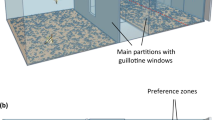Abstract
The ability to discriminate between larger and smaller quantities has been demonstrated in several mammalian and avian species suggesting the possibility of evolutionary conservation of this characteristic. Preference for the larger of two groups has also been shown in fish species, although this ability has rarely been systematically studied in lower order vertebrates, and thus the mechanisms of such ability are not understood. Here, we exploit the tendency of angelfish to seek protection in an unfamiliar environment by joining a group of conspecifics, a behaviour called shoaling. Test fish were given a simultaneous choice between shoals varying both in terms of numerical ratios and absolute numbers of fish. Our results provide evidence for quantity discrimination in angelfish. In general, experimental subjects chose the larger of two shoals. Furthermore, in agreement with Weber’s law, which holds that discrimination between two quantities depends on their ratio, the discrimination between shoals of different quantities of fish was more difficult when the shoal sizes became more similar. The limit of discrimination ratio was found to be below 2:1. Briefly, angelfish are able to discriminate between different quantities of conspecifics subject to a ratio limit, a finding that implies a fitness component in this behaviour similar to what has been demonstrated in higher order vertebrates.




Similar content being viewed by others
References
Agrillo C, Dadda M (2007) Discrimination of the larger shoal in the poeciliid fish Girardinus falcatus. Ethol Ecol Evol 19:145–157
Agrillo C, Dadda M, Bisazza A (2007) Quantity discrimination in female mosquitofish. Anim Cogn 10:63–70
Agrillo C, Dadda M, Serena G (2008a) Choice of female groups by male mosquitofish (Gambusia holbrooki). Ethology 118:479–488
Agrillo C, Dadda M, Serena G, Bisazza A (2008b) Do fish count? Spontaneous discrimination of quantity in female mosquitofish. Anim Cogn 11:495–503
Agrillo C, Dadda M, Serena G, Bisazza A (2009) Use of number by fish. PLoS ONE 4:e4786. doi:10.1371/journal.pone.0004786
Al Aïn S, Giret N, Grand M, Kreuitzer M, Bovet D (2009) The discrimination of discrete and continuous amounts in African grey parrots (Psittacus erithacus). Anim Cogn 12:145–154
Barber I, Wright HA (2001) How strong are familiarity preferences in shoaling fish? Anim Behav 61:973–979
Barreto RE, Rodrigues P, Luchiari AC, Delicio HC (2006) Time-place learning in individually reared angelfish, but not in pearl cichlid. Behav Proc 73:367–372
Beran M, Evans T, Leighty K, Harris E, Rice D (2008) Summation and quantity judgment of simultaneously and sequentially presented sets by capuchin monkeys (Cebus apella). Am J Primatol 70:191–194
Binoy VV, Thomas KJ (2004) The climbing perch (Anabas testudineus Bloch), a freshwater fish, prefers larger unfamiliar shoals to smaller familiar shoals. Curr Sci 86:207–211
Blakeslee C, McRobert SP, Brown AC, Clotfelter ED (2009) The effect of body coloration and group size on social partner preferences in female fighting fish (Betta splendens). Behav Proc 80:157–161
Bradner J, McRobert SP (2001) The effect of shoal size on patterns of body colour segregation in mollies. J Fish Biol 59:960–967
Buckingham JN, Wong BBM, Rosenthal GG (2007) Shoaling decisions in female swordtails: how do fish gauge group size? Behaviour 144:1333–1346
Capaldi EJ, Miller DJ (1988) Counting in rats: its functional significance and the independent cognitive processes that constitute it. J Exp Psychol Anim Behav Process 14:3–17
Carazo P, Font E, Forteza-Behrendt E, Desfilis E (2009) Quantity discrimination in Tenebrio molitor: evidence of numerosity discrimination in an invertebrate? Anim Cogn 12:463–470
Cordes S, Brannon E (2008) The difficulties of representing continuous extent in infancy: using number is just easier. Child Dev 79:476–489
Dadda M, Piffer L, Agrillo C, Bisazza A (2009) Spontaneous number representation in mosquitofish. Cognition 122:343–348
Davis H, Pérusse R (1988) Numerical competence in animals: definitional issues, current evidence, and a new research agenda. Behav Brain Sci 11:561–615
Day RL, Macdonald T, Brown C, Laland KN, Reader SM (2001) Interactions between shoal size and conformity in guppy social foraging. Anim Behav 62:917–925
Emmerton J, Renner JC (2006) Scalar effects in the visual discrimination of numerosity by pigeons. Learn Behav 34:176–192
Emmerton J, Renner JC (2009) Local rather than global processing of visual arrays in numerosity discrimination by pigeons (Columba livia). Anim Cogn 12:511–526
Feigenson L, Carey S, Hauser MD (2002) The representations underlying infants’ choice of more: object files versus analog magnitudes. Psychol Sci 13:150–156
Feigenson L, Dehaene S, Spelke E (2004) Core systems of number. Trends Cogn Sci 8:307–314
Foster WA, Treherne JE (1981) Evidence for the dilution effect in the selfish herd from fish predation on a marine insect. Nature 293:466–467
Frommen JG, Luz C, Bakker TCM (2007) Nutritional state influences shoaling preference for familiars. Zoology 110:369–376
Frommen JG, Hiermes M, Bakker TCM (2009) Disentangling the effects of group size and density on shoaling decisions of three-spined sticklebacks (Gasterosteus aculeatus). Behav Ecol Sociobiol 63:1141–1148
Gallistel CR, Gelman R (2000) Non-verbal numerical cognition: from the reals to the integers. Trends Cogn Sci 4:59–65
Gerlai R (2010) Zebrafish antipredatory responses: a future for translational research. Behav Brain Res 207:223–231
Godin J-GJ, Classon LJ, Abrahams MV (1988) Group vigilance and shoal size in a small characin fish. Behaviour 104:29–40
Gómez-Laplaza LM (2005) The influence of social status on shoaling preferences in the freshwater angelfish (Pterophyllum scalare). Behaviour 142:827–844
Gómez-Laplaza LM (2006) Shoal choice in juvenile angelfish (Pterophyllum scalare): effects of social status and activity. Ethol Ecol Evol 18:261–273
Gómez-Laplaza LM (2009) Recent social environment affects colour-assortative shoaling in juvenile angelfish (Pterophyllum scalare). Behav Proc 82:39–44
Gómez-Laplaza LM, Fuente A (2007) Shoaling decisions in angelfish: the roles of social status and familiarity. Ethology 113:847–855
Gómez-Laplaza LM, Morgan E (1991) Effects of short-term isolation on the locomotor activity of the angelfish (Pterophyllum scalare). J Comp Psychol 105:366–375
Gómez-Laplaza LM, Morgan E (2005) Time-place learning in the cichlid angelfish, Pterophyllum scalare. Behav Proc 70:177–181
Gross HJ, Pahl M, Si A, Zhu H, Tautz J, Zhang S (2009) Number-based visual generalisation in the honeybee. PLoS ONE 4:e4263. doi:10.1371/journal.pone.0004263
Hager MC, Helfman GS (1991) Safety in numbers: shoal size choice by minnows under predatory threat. Behav Ecol Sociobiol 29:271–276
Harcourt JL, Sweetman G, Johnstone A, Manica A (2009) Personality counts: the effect of boldness on shoal choice in three-spined sticklebacks. Anim Behav 77:1501–1505
Hauser MD, Carey S, Hauser L (2000) Spontaneous number representation in semi-free-ranging rhesus monkeys. Proc R Soc Lond B 267:829–833
Hauser MD, Tsao F, Garcia P, Spelke ES (2003) Evolutionary foundations of number: spontaneous representation of numerical magnitudes by cotton-top tamarins. Proc R Soc Lond B 270:1441–1446
Hensor EMA, Godin J-GJ, Hoare DJ, Krause J (2003) Effects of nutritional state on the shoaling tendency of banded killifish, Fundulus diaphanus, in the field. Anim Behav 65:663–669
Hoare DJ, Couzin ID, Godin J-GJ, Krause J (2004) Context-dependent group size choice in fish. Anim Behav 67:155–164
Jaakkola K, Fellner W, Erb L, Rodriguez M, Guarino E (2005) Understanding of the concept of numerically “less” by bottlenose dolphins (Tursiops truncatus). J Comp Psychol 119:286–303
Krakauer DC (1995) Groups confuse predators by exploiting perceptual bottlenecks: a connectionist model of the confusion effect. Behav Ecol Sociobiol 36:421–429
Krause J, Godin J-GJ (1994) Shoal choice in banded killifish (Fundulus diaphanus, Teleostei, Cyprinodontidae): effects of predation risk, fish size, species composition and size of shoals. Ethology 98:128–136
Krause J, Ruxton GD (2002) Living in groups. Oxford University Press, Oxford
Krause J, Godin J-GJ, Rubenstein D (1998) Group choice as a function of group size differences and assessment time in fish: the influence of species vulnerability to predation. Ethology 104:68–74
Landeau L, Terborgh J (1986) Oddity and the ‘confusion effect’ in predation. Anim Behav 34:1372–1380
Lipton JS, Spelke ES (2003) Origins of number sense: large number discrimination in human infants. Psychol Sci 15:396–401
Miller N, Gerlai R (2007) Quantification of shoaling behaviour in zebrafish (Danio rerio). Behav Brain Res 184:157–166
Miller N, Gerlai R (2008) Oscillations in shoal cohesion in zebrafish (Danio rerio). Behav Brain Res 193:148–151
Morgan MJ, Godin J-GJ (1985) Antipredator benefits of schooling behavior in a cyprinodontoid fish, the banded killifish (Fundulus diaphanus). Z Tierpsychol 70:236–246
Pepperberg IM (2006) Grey parrot numerical competence. A review. Anim Cogn 9:377–391
Pitcher TJ, Parrish JK (1993) Functions of shoaling behaviour in teleosts. In: Pitcher TJ (ed) Behaviour of teleost fishes, 2nd edn. Chapman and Hall, London, pp 363–439
Pitcher TJ, Magurran AE, Winfield IJ (1982) Fish in larger shoals find food faster. Behav Ecol Sociobiol 10:149–151
Praetorius W (1932) How the “king” lives at home. Aquarium 1:119–120 141
Pritchard VL, Lawrence J, Butlin RK, Krause J (2001) Shoal choice in zebrafish, Danio rerio: the influence of shoal size and activity. Anim Behav 62:1085–1088
Rugani R, Regolin L, Vallortigara G (2008) Discrimination of small numerosities in young chicks. J Exp Psychol Anim Behav Process 34:388–399
Svensson PA, Barber I, Forsgren E (2000) Shoaling behaviour of the two-spotted goby. J Fish Biol 56:1477–1487
Tegeder RW, Krause J (1995) Density dependence and numerosity in fright stimulated aggregation behaviour of shoaling fish. Phil Trans R Soc Lond B 350:381–390
Trick L, Pylyshyn Z (1994) Why are small and large numbers enumerated differently? A limited capacity preattentive stage in vision. Psychol Rev 101:80–102
Uller C, Lewis J (2009) Horses (Equus caballus) select the greater of two quantities in small numerical contrasts. Anim Cogn 12:733–738
Uller C, Hauser M, Carey S (2001) Spontaneous representation of number in cotton-top tamarins. J Comp Psychol 115:248–257
Uller C, Jaeger R, Guidry G, Martin C (2003) Salamanders (Plethodon cinereus) go for more: rudiments of number in an amphibian. Anim Cogn 6:105–112
Ward C, Smuts B (2007) Quantity based judgments in the domestic dog (Canis lupus familiaris). Anim Cogn 10:71–80
Xu F (2003) Numerosity discrimination in infants: evidence for two systems of representations. Cognition 89:B15–B25
Xu F, Spelke ES, Goddard S (2005) Number sense in human infants. Develop Sci 8:88–101
Acknowledgments
We are grateful to three anonymous reviewers for their useful comments on the manuscript. R. G. was supported by a NSERC (Canada) grant. The University of Oviedo provided a visiting grant to L.M.G-L. The experiments described here comply with the current laws of the country (Spain) in which they were performed. The authors declare that they have no conflict of interest.
Author information
Authors and Affiliations
Corresponding authors
Rights and permissions
About this article
Cite this article
Gómez-Laplaza, L.M., Gerlai, R. Can angelfish (Pterophyllum scalare) count? Discrimination between different shoal sizes follows Weber’s law. Anim Cogn 14, 1–9 (2011). https://doi.org/10.1007/s10071-010-0337-6
Received:
Revised:
Accepted:
Published:
Issue Date:
DOI: https://doi.org/10.1007/s10071-010-0337-6




